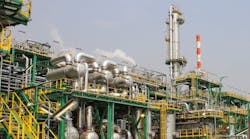Oil and product prices seesawed in early January.
Concerns about low U.S. gasoline inventories and much warmer January weather after a bitterly cold December led to several days of sharp gains and declines.
WTI futures in the U.S. for February delivery closed Jan. 10 at $22.90/bbl, down 780 from the recent high of $23.68/bbl Jan. 3. The closing price fell as low as $21.62/bbl earlier last week.
Unleaded gasoline futures for February delivery dipped to about 61/gal Jan. 8 from more than 67/gal Jan. 3.
They then climbed to more than 64/gal Jan. 10 when American Petroleum Institute reported a larger than expected drop in gasoline inventories in the week ended Jan. 5.
Delta Air Lines hiked fares 47% citing jet fuel expenses that ere 45% higher in December 1989 than December 1988 and a 43% increase in fourth quarter 1989 from fourth quarter 1988.
European crude prices also seemed to be on a roller-coaster.
After touching a 4 year high of $21.80/bbl early last
week, Brent blend prices tumbled to $20.30/bbl for February delivery in what traders described as a technical correction to strong early 1990 gains.
Within a day prices had recovered to $21.10/bbl, and traders said more sharp fluctuations could be expected in the short term.
Meanwhile, the average spot price of the OPEC basket of crudes rose 21.2% on the year to $17.31/bbl in 1989, Middle East Economic Survey calculated.
Worldwide crude supplies ended the 1980s on a high note.
Fourth quarter supply was 54.8 million b/d, 1.5 million b/d more than in fourth quarter 1988 and the highest quarterly figure reported by the International Energy Agency during the 1980S.
OPEC supply topped 23.9 million b/d in December, 100,000 b/d more than a revised November figure.
However, OECD oil consumption grew only modestly. Final third quarter 1989 data in IEA's January 1990 market report put consumption at 36.3 million b/d, only marginally higher than in 1988.
Worldwide consumption outside the centrally planned economies rose 1.4% during the same period to 50.8 million b/d.
Preliminary data and estimates for the final quarter of last year show that OECD consumption rose by 0.3% to 39.2 million b/d vs. the last quarter of 1988. The agency forecasts a rise of 1.57, in OECD demand in 1990 to 37.9 million b/d.
Total CFP of France signed a contract with Thailand's Industry Ministry to develop and operate B structure in the Gulf of Thailand about 150 miles off southeastern Thailand.
Development of the 3.5 tcf reservoir will cost $600 million. Gas should start to flow in 1993 and reach a plateau of 350 MMcfd.
Total has a 30% stake, and the state company PTT Exploration & Production holds 40%. The other 30% is likely to be distributed between British Gas plc and Den norkse stats oljeselskap AS.
Iran, through its deputy mines minister, has proposed an $11.7 billion, 2,000 mile pipeline to ship associated gas from Iranian Persian Gulf oil fields to India and Pakistan.
The pipeline would transport about 1 bcfd to Pakistan and 2.47 bcfd to India.
India would use the gas in northern petrochemical, fertilizer, and electric power plants, freeing indigenous production to feed a planned pipeline grid from the West Coast to southern India.
India's downstream plans continue changing with the political winds (OGJ, Nov. 27, 1989, p. 37). The proposed 120,000 b/d refinery at Karnal may be moving off high center again.
Former Prime Minister Rajiv Gandhi broke ground for the plant 3 years ago to win votes in Haryana state but lost an assembly election and subsequently slowed plans for the project.
With Prime Minister Singh's National Front party ruling in New Delhi and Haryana, project plans are proceeding afresh.
Indian Oil Corp. (IOC), India's Tatas, and the U.S.S.R. are partners in the project.
Meanwhile, IOC plans to boost crude distillation capacity in Assam state to 147,000 b/d by 1993-94 to accommodate growing crude production in northeastern India.
Plans call for another 3,000 b/d each at Guwahati and Digbei refineries and another 18,400 b/d at Barauni refinery.
Together with the planned refinery at Numaligarh, Assam refineries will be able to take all of Northeast India's crude output expected to peak at about 204,200 b/d in the mid-1990s.
Total CFP plans to develop a branded gasoline service station network in Hungary as part of a joint venture with the state companies Afor and Mineralimpex.
Total expects to have 40 stations in service by 1992-93 and should gain about 6% of the local gasoline market.
Total also intends to manufacture and sell lube oils and expects to win 5-10% of that market.
Royal Dutch/Shell Group entered Hungary's market earlier.
Mitsubishi Petrochemical Co. will file a plan early this year with the Ministry of International Trade and Industry to build a 300,000 ton/year ethylene plant, the first to be constructed in Japan in 7 years.
Construction of the plant, in the Kashima district of Ibaraki prefecture, will take 2-3 years. The company said Japanese ethylene production will match productive capacity of 5.8 million tons/year this year.
Pres. Soeharto presented parliament a fiscal 1990-91 budget for Indonesia that projects revenues based on oil prices of $16.50/bbl, up from $14/bbl used to calculate the last budget.
Oil prices in 1989 are expected to yield $2-3 billion more in revenue than anticipated in the budget for the year ending Mar. 31, 1990.
The District of Columbia U.S. Court of Appeals has rejected the Federal Energy Regulatory Commission's passthrough mechanism under the Order 500 open access transportation rule.
The mechanism allowed a pipeline to pass some take or pay liability through to customers if it absorbed the same percentage of liability.
The court, in Associated Gas Distributors vs. FERC, ruled that amounted to retroactive ratemaking and was unfair to some pipeline customers.
The Natural Gas Supply Association called the ruling a step backward.
Rep. Dan Rostenkowski (D-Ill.), chairman of the tax-writing House ways and means committee, again proposes to raise the 9.1/gal federal gasoline excise tax, this time by 15/gal.
Rostenkowski said the revenue would be dedicated to various programs, including repair of highways and bridges. The Bush administration opposed a gasoline tax increase last year.
Copyright 1990 Oil & Gas Journal. All Rights Reserved.

